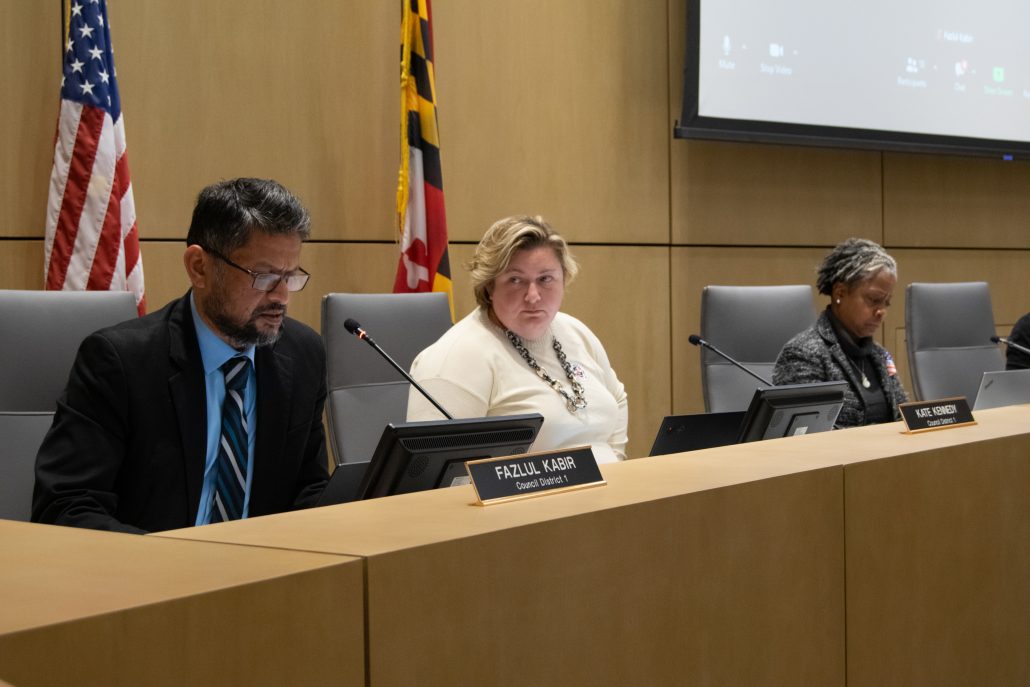By Will Beltran
College Park City Councilmembers unanimously approved a new district map during their meeting on Nov. 15. The new districts be in effect prior to the November 2023 city election.

Credit: Anton Van De Motter
The council passed the October Plan 1 map, which keeps the core neighborhoods of the current districts intact. This map was created in response to the public outcry against the redistricting commission’s original proposals, which broke up districts’ core neighborhoods.
A second proposal, the Plan 3A map, was one of the redistricting commission’s original recommended maps and was the second option the council had been considering. The redistricting commission saw this plan as a good option, in that it would distribute the University of Maryland’s student population relatively evenly among the city’s four districts. While students count towards the city population, they are far less likely to vote than are permanent residents. This leads to an imbalance in participation, as districts with higher student populations will have lower voter turnout than districts with higher populations of permanent residents.
A number of residents voiced concerns at a public hearing that took place prior to the council’s Nov. 15 meeting.
Resident Mary King supported the Plan 3A map. ”I think it is sound in what the city needs,” she said.
Tanya Lervik, who also lives in the city, spoke in favor of the October Plan 1 map, noting that she does not want her district to change.
Each councilmember explained why they supported the October Plan 1 map. Councilmember Susan Whitney (District 2) also spoke against the Plan 3A map, noting that the map, had it been approved, would have unevenly distributed the city’s civic associations.
“The fact that so many civic associations would be concentrated in District 2 really shows an imbalance,” she said.
District 4 Councilmembers Maria Mackie and Denise Mitchell believe that the October Plan 1 map is best for the city, but both were discouraged that their district will lose the Cherry Hill and Autoville neighborhoods to District 1 under that map.
“One of the reasons that Autoville and Cherry Hill will no longer be in District 4 is because they’re the means to allowing District 1 to come down into [areas with student housing]. I think that’s very important that people understand that,” Mackie noted. “Although I’ll be very sad to lose those two neighborhoods in my district, this isn’t just about me — this is about all of College Park.”
Councilmember Kate Kennedy (District 1) also supported the October Plan 1 map, though she expressed concern that District 1 would have a disproportionately high number of active voters. She said this may discourage residents in the district from running for council against incumbents, as campaigning would call for knocking on more doors in the district.
“We’re doing a disservice to our [District 1] residents to have so many active voters in that district,” Kennedy said.
District 3 stood to be divided by the commission’s original maps, but the October Plan 1 map hardly changes the district’s borders at all. Councilmember John Rigg (District 3) surmised that most people will be satisfied that the city’s core neighborhoods will remain intact.
“October Plan 1 seems to receive a lot more support from people who’ve been speaking with us in public session, but also in private conversation, since these were announced,” he said.
Councilmember Llatetra Brown Esters (District 2) added that she wants students to become more involved with the council in hopes that more of them will choose to vote, too; this could lead to more balanced distribution of voters among the districts.
“Despite whatever this redistricting plan becomes, I do hope that students will get involved in voting, as they live in the city, and we want them to have more of a voice,” Brown Esters noted.
Under provisions of the new map, District 1 will include Hollywood, Edgewood and most of Daniels Park, with the additions of Cherry Hill and Autoville. The northern boundary of the district is unchanged, extending to the city limits just north of Interstate 495.
District 2 will continue to include Berwyn, Lakeland, Branchville and a portion of Daniels Park. The October Plan 1 map adds portions of the university’s campus to the district, including the engineering buildings, the farm and some student housing. The portions of south campus currently in District 2 will be redesignated to District 4.
District 3’s boundaries remain largely unchanged. The district will include Old Town, Calvert Hills, Yarrow, College Park Estates, the Lake Artemesia area and the College Park Airport.
District 4 will include the College Park Woods and Crystal Springs neighborhoods, along with south campus, the university’s golf course and the UMD Global Campus, which is located on University Boulevard.







